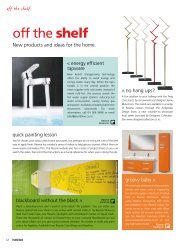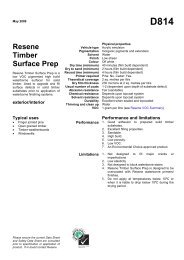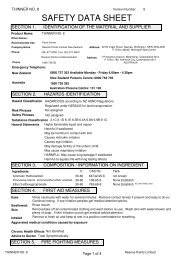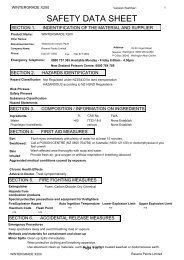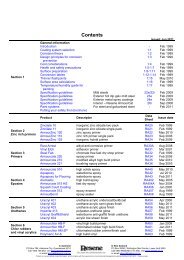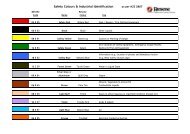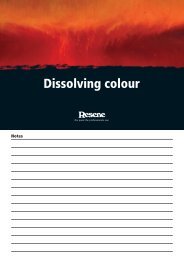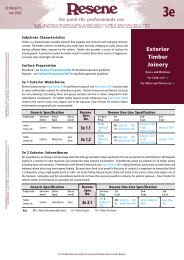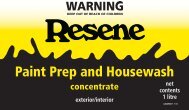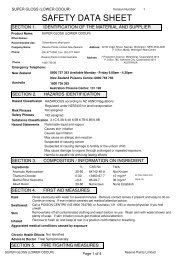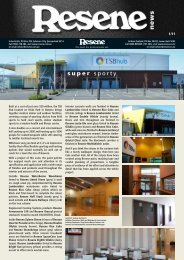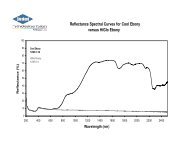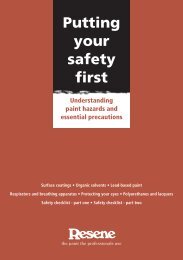Matai - Resene
Matai - Resene
Matai - Resene
Create successful ePaper yourself
Turn your PDF publications into a flip-book with our unique Google optimized e-Paper software.
CF198-6711Mar 2006 9eaccess specification information online at www.resene.co.nz (NZ) or www.resene.com.au (AUST)minimise the effect of your project on the environment – see www.resene.co.nz/paintwise.htmIn Australia: <strong>Resene</strong> Paints (Aust) Limited, 7 Production Ave, PO Box 785, Ashmore City, Queensland 4214Phone 1800 738 383 Fax 1800 064 960 Email advice@resene.com.au or visit www.resene.com.auIn New Zealand: <strong>Resene</strong> Paints Limited, Vogel Street, PO Box 38242, Wellington Mail Centre, Lower Hutt 5045Phone 0800 RESENE Fax (04) 577 0600 Email advice@resene.co.nz or visit www.resene.co.nzSubstrate CharacteristicsTimber is a dimensionally unstable material that expands and contracts with changing moisturecontent. The timber surface is eroded by ultra violet light, normally changing to a grey colourleaving cellulose fibres exposed on the surface. Timber also provides a source of nutrient for mouldgrowth. A protective system for timber needs to combat these three sources of aggression, viz.water, ultra violet light and mould. Naturally occurring anti-oxidants in <strong>Matai</strong>, Merbeau, SpottedGum and Totara inhibit the curing of oxidatively drying paints including solventborne enamels,primers, undercoats, oil modified urethanes and solventborne stains. These materials may transferthrough any solventborne system to affect subsequent coats. Highly filled undercoats may give animpression of having dried without really curing.Surface PreparationNew Work - see Surface Preparation D82 for detailed preparation guidelines.Repaints - see Surface Preparation D87 for detailed preparation guidelines.Exterior<strong>Matai</strong>,Merbeau,Spotted Gumand Totaraonly9e 1 Exterior WaterborneWaterborne paints are most suitable for exterior applications being more durable and flexible thansolventborne paints. All unsealed cracks and end grains must be sealed to prevent moisturepenetration. Sharp edges on timber are difficult to coat as paint tends to flow away from edges leaving weak spots – ensure all sharp edgesand rough profiles are rounded before painting to promote good film build. Optional over bare timber is pretreatment with <strong>Resene</strong> TimberLock(see Data Sheet D48) to improve the durability of subsequent coatings. For better hiding, <strong>Resene</strong> Acrylic Undercoat (see Data Sheet D404)tinted to the correct colour may replace one of the topcoats.Generic Specification <strong>Resene</strong> <strong>Resene</strong> One-Line SpecificationSubstrate Environ- Paint Gloss Spec Surface 1st 2nd 3rdment Type Level No. Prep Coat Coat Coat<strong>Matai</strong>, MerbeauD82 &Hi-Glo * D31 Hi-Glo *Spotted Gum Exterior Waterborne Gloss 9e 1.1 TimberLock Quick Dry D45Acrylic Undercoat D404 D31and TotaraD48<strong>Matai</strong>, MerbeauD82 &Sonyx 101 * D30 Sonyx 101 *Spotted Gum Exterior WaterborneSemi-9e 1.2 TimberLock Quick Dry D45Acrylic Undercoat D404 D30and TotaraGlossD48<strong>Matai</strong>, MerbeauD82 &NRS: Quick Dry D45Lumbersider D34LumbersiderSpotted Gum Exterior Waterborne Satin 9e 1.3 TimberLock Acrylic Undercoat D404D34and Totara D48 SP: Lumbersider D34 Lumbersider D34* For doors, windows and joinery, use <strong>Resene</strong> Enamacryl (see Data Sheet D309) in place of <strong>Resene</strong> Hi-Glo (seeData Sheet D31) and <strong>Resene</strong> Lustacryl (see Data Sheet D310) in place of <strong>Resene</strong> Sonyx 101 (see Data Sheet D30).9e 2 Exterior Solventborne<strong>Resene</strong> Quick Dry Acrylic Primer (see Data Sheet D45) is the recommended primer for maximum flexibility and durability and required to sealoff the anti-oxidant in the timber. All solventborne air-drying enamels slowly embrittle with age and dark colours exposed to the sun acceleratethis embrittlement. Windowsills angled in a manner to catch maximum sun provide the most stressful environment. Solventborne paints aresuitable for all timber joinery including doors and windows. Because doors tend to be people’s first point of contact, it is important animmaculate finish is achieved by using a high quality brush or roller. Optional over bare timber is pretreatment with <strong>Resene</strong> TimberLock toimprove the durability of subsequent coatings. For better hiding, <strong>Resene</strong> Acrylic Undercoat tinted to the correct colour may replace one of thetopcoats. Semi-gloss and flat solventborne paints do not have the necessary weather resistance for exterior exposure. Clear finishes forexterior timber environments are generally not recommended.Generic Specification <strong>Resene</strong> <strong>Resene</strong> One-Line SpecificationSpecNo.Substrate Environ- Paint Gloss Surface 1st 2nd 3rdment Type Level Prep Coat Coat Coat<strong>Matai</strong>, MerbeauD82 &Spotted Gum Exterior Solventborne Gloss 9e 2.1 TimberLockand TotaraD48Key: NRS = Normal Recommended System SP = Self PrimingQuick Dry Acrylic Undercoat Super GlossD45 D404 D32If in doubt about any aspect of your specification please contact <strong>Resene</strong>.
CF198-6711Mar 2006 9e/iaccess specification information online at www.resene.co.nz (NZ) or www.resene.com.au (AUST)minimise the effect of your project on the environment – see www.resene.co.nz/paintwise.htmIn Australia: <strong>Resene</strong> Paints (Aust) Limited, 7 Production Ave, PO Box 785, Ashmore City, Queensland 4214Phone 1800 738 383 Fax 1800 064 960 Email advice@resene.com.au or visit www.resene.com.auIn New Zealand: <strong>Resene</strong> Paints Limited, Vogel Street, PO Box 38242, Wellington Mail Centre, Lower Hutt 5045Phone 0800 RESENE Fax (04) 577 0600 Email advice@resene.co.nz or visit www.resene.co.nzSubstrate CharacteristicsTimber is a dimensionally unstable material that expands and contracts with changing moisture content.The timber surface is eroded by ultra violet light, normally changing to a grey colour leaving cellulosefibres exposed on the surface. Timber also provides a source of nutrient for mould growth. A protectivesystem for timber needs to combat these three sources of aggression; viz. water, ultra violet light andmould. Naturally occurring anti-oxidants in <strong>Matai</strong>, Merbeau, Spotted Gum and Totara inhibit thecuring of oxidatively drying paints including solventborne paints, primers, undercoats, oil modifiedurethanes and solventborne stains. These materials may transfer through any solventborne systemto affect subsequent coats. Highly filled undercoats may give an impression of having dried withoutreally curing.Surface PreparationNew Work - see Surface Preparation D82 for detailed preparation guidelines.Repaints - see Surface Preparation D87 for detailed preparation guidelines.9e 3/4 Exterior Waterborne/SolventborneGenerally solventborne, oxidatively film forming stains cannot successfully be used, due to thepresence of anti-oxidants in the timber. Non film forming, penetrating stains, such as <strong>Resene</strong>Woodsman (waterborne see Data Sheet D57a, solventborne see Data Sheet D57) are suitable buteven so, excess material must be wiped from the surface. Semi-transparent stains are not as durable as fully pigmented systems and <strong>Resene</strong>Woodsman will require maintenance after two summers.Generic Specification <strong>Resene</strong> <strong>Resene</strong> One-Line SpecificationSubstrate Environ- Paint Gloss Spec Surface 1st 2nd 3rdment Type Level No. Prep Coat Coat Coat<strong>Matai</strong>, MerbeauWaterborne WaterborneWaterborneSpotted Gum Exterior Waterborne Flat 9e 3.5 D82Woodsman D57a Woodsman D57aWoodsman D57aand Totara(after 3 months)<strong>Matai</strong>, MerbeauWoodsman D57Spotted Gum Exterior Solventborne Flat 9e 4.5 D82 Woodsman D57 Woodsman D57(after 3 months)and Totara9i 3/4 Interior Waterborne/SolventborneEnsure sharp edges and rough profiles are rounded before painting to promote good film build. All unsealed cracks and end grains, such asunder doors, must be sealed to prevent isolated blistering caused by moisture penetration. For floors and where a really tough surface isrequired <strong>Resene</strong> Polythane (see Data Sheet D53) is the best recommendation. An additional coat is recommended on flooring surfaces.Oxidatively drying clears such as the <strong>Resene</strong> Qristal Clear polyurethane range (see Data Sheet D52) require a waterborne sealer to seal off thenatural anti-oxidants present in <strong>Matai</strong>, Merbeau, Spotted Gum and Totara.Key: HDS = Heavy Duty System NRS = Normal Recommended SystemIf in doubt about any aspect of your specification please contact <strong>Resene</strong>.Exterior andInteriorStainsand ClearFinisheson <strong>Matai</strong>,Merbeau,Spotted Gumand TotaraGeneric Specification <strong>Resene</strong>Spec<strong>Resene</strong> One-Line SpecificationNo.Substrate Environ- Paint Gloss Surface 1st 2nd 3rd 4th Coatment Type Level Prep Coat Coat Coat optional<strong>Matai</strong>, MerbeauSpotted Gum Interior Waterborne Gloss 9i 3.1 D82 Aquaclear D59 Aquaclear D59 Aquaclear D59 Aquaclear D59and Totara<strong>Matai</strong>, MerbeauSpotted Gum Interior Waterborneand TotaraSemi-Gloss9i 3.2 D82 Aquaclear D59 Aquaclear D59 Aquaclear D59 Aquaclear D59<strong>Matai</strong>, MerbeauSpotted Gum Interior Waterborne Satin 9i 3.3 D82 Aquaclear D59 Aquaclear D59 Aquaclear D59 Aquaclear D59and Totara<strong>Matai</strong>, MerbeauSpotted Gum Interior Solventborne Gloss 9i 4.1 D82and TotaraNRS: Aquaclear D59 Poly-Gloss D52 Poly-Gloss D52 Poly-Gloss D52HDS: Polythane D53 Polythane D53 Polythane D53 Polythane D53<strong>Matai</strong>, MerbeauSpotted Gum Interior Solventborne Satin 9i 4.3 D82 Aquaclear D59 Poly-Satin D52 Poly-Satin D52 Poly-Satin D52and Totara<strong>Matai</strong>, MerbeauSpotted Gum Interior Solventborne Flat 9i 4.5 D82 Aquaclear D59 Poly-Flat D52 Poly-Flat D52 Poly-Flat D52and Totara



